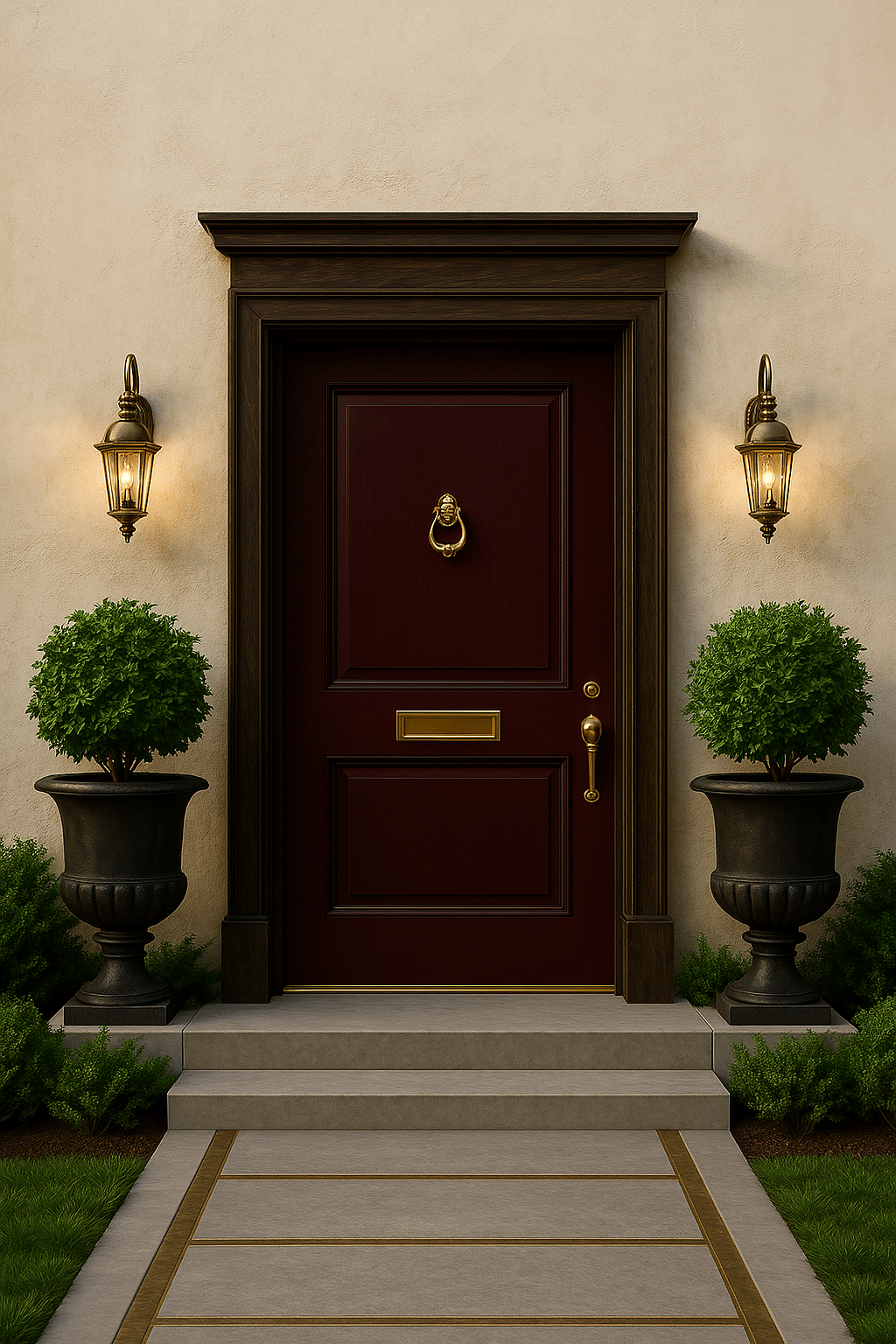What are the best front door colors for a wood front door? That’s the question every homeowner ends up asking the moment they realize their entryway feels… off. Maybe it’s outdated. Maybe it blends in too much. Or maybe it just doesn’t do justice to the rich grain of that solid wood.
Front door colors for a wood front door aren’t about following trends—they’re about making the entrance feel intentional, bold, and like it actually belongs. Whether you’re restoring an old craftsman or finishing up a modern build, the color you choose tells people what to expect before they even knock.
This guide breaks down what’s working in 2025—from natural wood finishes and deep espresso stains to rich greens, blues, and statement shades that make your wood front door the focal point it deserves to be.
🔑 Key Takeaways: Front Door Colors for Wood Front Doors
| What You Need to Know | Why It Matters |
|---|---|
| Your front door color sets the tone. | It’s the first thing people notice—make it count. A great color can add curb appeal and perceived value instantly. |
| Wood front doors deserve better than boring paint. | The grain, the texture, the warmth—highlight it with clear coats or rich stains, not flat plastic-y paint. |
| Natural wood is having a major moment. | Especially with modern and farmhouse designs. Let the wood grain be the star. It looks expensive because it is. |
| Green, blue, and warm earth tones are trending hard. | Sage, navy, olive, terra cotta, golden yellow—they all bring personality without screaming “Pinterest fail.” |
| Trim color matters just as much as door color. | Don’t pair the perfect door with a sloppy trim choice. White, putty, black, and wood-stained trims each tell a different story. |
| Lighting changes everything. | Morning, evening, shadow, sun—test your color in different light or you’ll be stuck with a surprise hue. |
| Prep the surface like you care. | Skipping sanding or primer guarantees a patchy, flaky disaster. Whether it’s paint or stain, the prep makes or breaks it. |
| Use pro-grade products. | Cheap paint fades fast. Use exterior-grade, UV-resistant finishes and seal it properly—especially on sun-facing doors. |

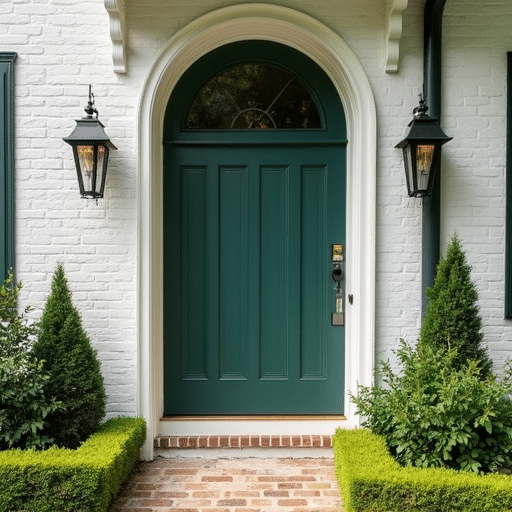
Why Picking the Right Front Door Colors Isn’t Just About Paint
Here’s what most people get wrong: they think the front door is just a detail. It’s not.
Your front door is the first impression, the handshake, the welcome mat with teeth. If you’ve got a wood front door, congratulations—you’ve already won half the battle. Wood looks rich. Feels solid. Ages like George Clooney. But if the color’s off? It cheapens the whole facade.
People hesitate because they don’t want to mess it up. They’re standing in front of their wood door with a color swatch thinking, Is this too bold? Too boring? Too 2013? You’re not alone. Let’s fix that.
Front Door Colors for Wood Front Doors: Why They Deserve Special Treatment
A wood front door has something painted fiberglass never will—soul. It’s got texture. It’s got warmth. It changes with the light and never goes out of style.
Whether you’re sticking with natural wood finishes or planning to paint, the rules aren’t the same as with metal or composite. With wood, the grain talks back. The color isn’t just sitting on the surface—it’s part of the story.
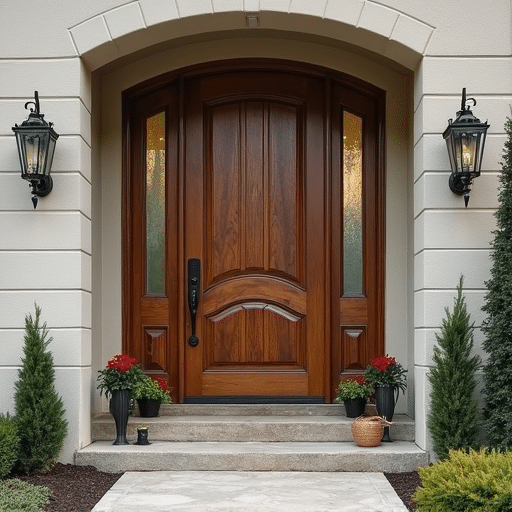
Front Door Colors for Natural Wood Finishes That Let the Grain Do the Talking
Keep It Natural (Literally)
Some people get it: they don’t want to cover the grain. They want to showcase it. For that, you’re looking at:
- Clear Coats – Transparent finishes that protect and show off the wood’s raw charm.
- Medium Maple Stains – Warm but not overpowering. Rustic, but still clean.
- Espresso or Deep Walnut – Black front door drama without shouting. It whispers luxury.
Wood Types That Look Good Naked
Let’s break down some winners:
- Mahogany – Deep, warm, and rich. This is the tuxedo of wood doors.
- White Oak – Light and airy. Looks killer with black or brass hardware.
- Walnut – Sophisticated and dark with wild grain patterns that make people do double takes.

Front Door Colors That Work on Wood (Even When Painted)
Greens: The MVP of 2025
Green isn’t just green anymore. It’s a whole spectrum of moods:
- Deep Forest Green – Elegant, moody, and killer against stone or white trim.
- Sage – Understated and soothing. Perfect for homes surrounded by trees or shrubs.
- Olive – Earthy with just the right amount of attitude.
It’s the “I’m stylish, but I grow my own herbs” vibe. People love it.
Blue-Greens & Blues: Coastal Cool Meets Timeless Class
You can’t go wrong with these:
- Teal – A little boho, a little bold.
- Navy – Classic. Solid. Looks amazing on traditional homes with white or red brick.
- Dusty Blue-Green – Calming and friendly. Think beach cottage but elevated.
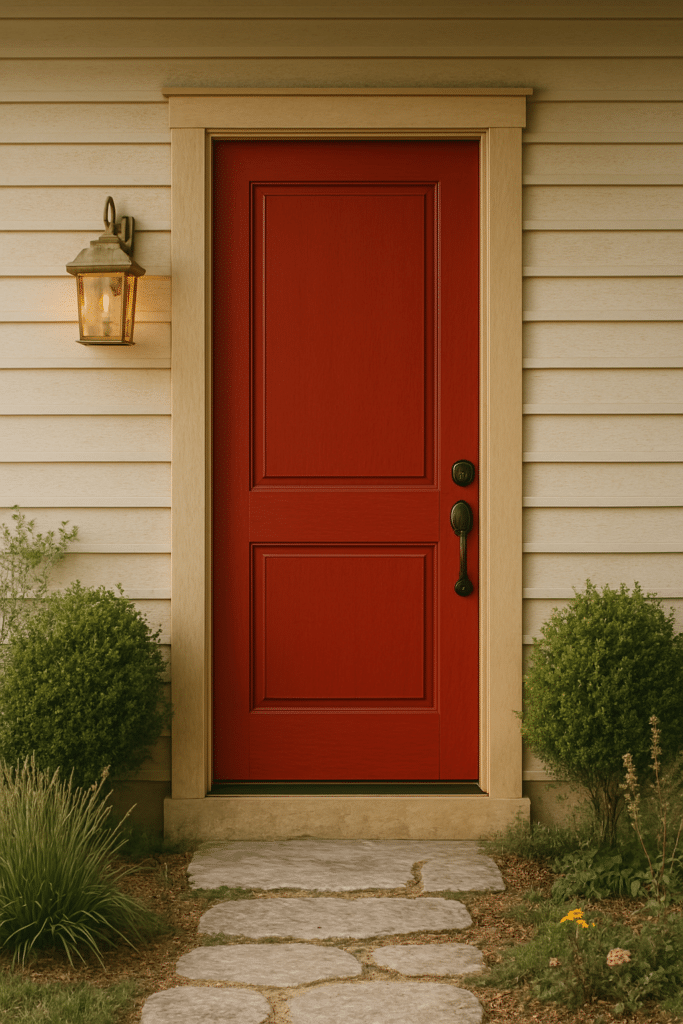
Front Door Colors That Make a Statement
Feeling bolder? Good.
- Golden Yellow – Bright, warm, and always cheerful. Like sunshine in a can.
- Sunset Orange – Not for the faint of heart. Works well with rustic woods or dark siding.
- Deep Plum – Luxurious and a bit mysterious.
- Classic Red – Not fire truck red—think cranberry or brick. Makes your house pop without looking like a diner.
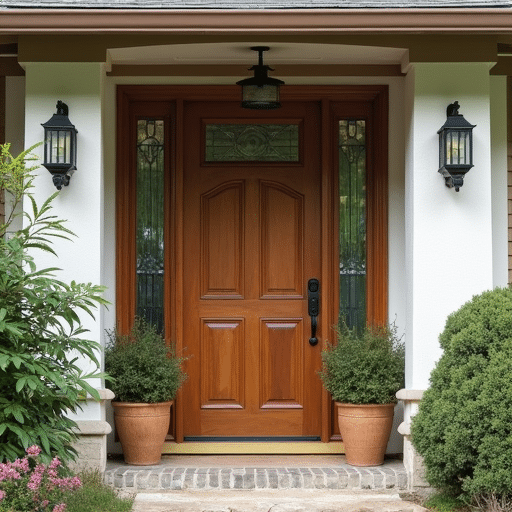
How to Pick the Right Front Door Colors for Your Home
Match Your Home’s Style
Not every color belongs on every house. Some guidelines:
- Colonials & Traditional Homes – Stick with deep, rich tones or natural stains. Mahogany, espresso, navy, or brick red.
- Modern Builds – Go bold. Teal, olive, black, or even a stark clear coat on white oak.
- Cottages & Craftsman – These thrive on warmth. Sage, mustard, burgundy, or walnut.
Let Your Surroundings Guide You
Your door doesn’t exist in a vacuum. Look around:
- Are you surrounded by trees? Sage or olive blend beautifully.
- Got stone or brick on the exterior? Navy, red, or espresso will contrast perfectly.
- Bright porch with lots of light? You can go darker.
- Shady entry? Lean into warm or bright hues for visibility and charm.
Color Psychology (Because Vibes Matter)
- Blue = Trust, calm, stability
- Green = Nature, peace, growth
- Red/Orange = Energy, warmth, confidence
- Yellow = Joy, optimism, creativity
- Black/Dark Wood = Class, security, boldness
Pick the one that makes you feel something. You’ll be the one coming home to it every day.
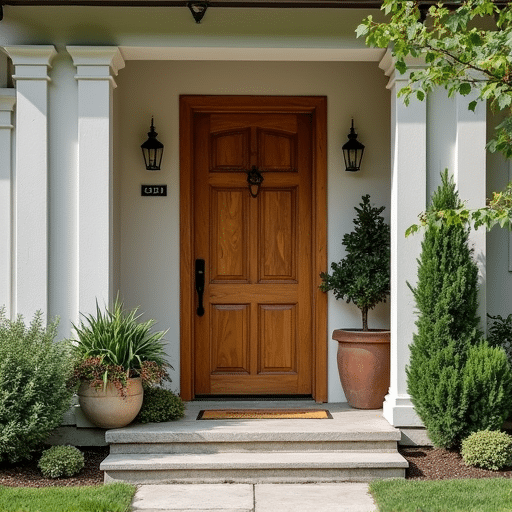
Getting It Right: Prep Work That Actually Pays Off
Even the best color in the world won’t save a poor finish. Prep is key. Don’t shortcut it.
For Staining:
- Sand like it owes you money. Uneven surfaces will ruin your stain.
- Use a pre-stain conditioner. Especially if your door’s older or softwood.
- Test swatches in daylight. Natural light changes everything.
For Painting:
- Primer is non-negotiable. Use one made for exterior wood.
- Use a quality exterior-grade paint. Don’t cheap out. UV resistance matters.
- Seal it. Even painted doors benefit from a clear coat or sealer.
Product Tips That Save You Headaches Later
- Oil-based stains and sealers last longer and deepen the wood’s look.
- Exterior paints with UV blockers stop fading—especially on south-facing doors.
- A satin or semi-gloss finish holds up better than flat. It also hides dirt and fingerprints.

Front Door Colors & Trim Combos That Actually Look Good Together
A killer front door color can still fall flat if the trim doesn’t play nice. The trim is the frame around the painting—and it can either make the door pop, or suck the life out of it.
You’d be surprised how often people nail the door color… then slap on a trim that ruins everything.
Here’s what works—real combinations that look intentional, not accidental.
1. Natural Wood Door + Crisp White Trim
Why it works: The contrast is clean, classic, and high-end. It highlights the warmth and grain of the wood without competing with it.
Pairs well with:
- Mahogany door + Pure white trim
- Walnut stain + Soft white (think Benjamin Moore “Chantilly Lace”)
- Clear coat oak + Matte white trim for that modern-farmhouse look
Style vibe: Timeless. This combo works with colonial, craftsman, modern—you name it.
2. Deep Green Door + Warm White or Cream Trim
Why it works: Green can skew cold if you’re not careful. A warm-toned trim keeps the entryway looking rich, not rigid.
Perfect pairings:
- Forest green + Creamy ivory trim
- Sage green + Light tan trim
- Olive + Off-white with a yellow undertone
Style vibe: Cozy but elevated. Think English cottage meets West Coast craftsman.
3. Navy or Deep Blue Door + Soft Gray or Putty Trim
Why it works: Gray softens the punch of dark blue and gives it a sophisticated edge.
Try these:
- Navy blue door + Greige trim
- Dusty blue-green + French gray
- Teal door + Warm concrete gray trim
Style vibe: Subtle confidence. Works especially well with brick or stone exteriors.
4. Charcoal or Black Door + Wood-Stained Trim
Why it works: Flipping the script—dark door, wood trim—feels unexpected and grounded.
Winning combos:
- Matte black door + Medium walnut trim
- Charcoal door + Clear-coated cedar
- Espresso paint + Golden oak trim
Style vibe: Modern rustic. Feels intentional, bold, and design-savvy.
5. Sunset Colors (Reds, Oranges, Yellows) + Neutral Trim
Why it works: Bold colors need a supporting actor. Keep the trim neutral and let the door carry the show.
Color combos that hit:
- Terracotta red + Mushroom beige trim
- Marigold yellow + Soft taupe trim
- Burnt orange + Cream or almond trim
Style vibe: Warm, welcoming, and full of personality. Works especially well on craftsman bungalows and eclectic homes.
6. Stained Wood Door + Black Trim
Why it works: This is the move if you’re into that high-contrast, modern look.
Go-to mixes:
- Clear-coated oak door + Matte black trim
- Deep walnut stain + Satin black trim
- Medium brown stain + Iron ore or charcoal trim
Style vibe: Strong and architectural. Looks amazing with white or off-white siding.
Quick Tip:
Before committing, test your combos in actual daylight. The direction your door faces affects everything. Morning sun can bleach out soft trim tones, while evening light can warm up even the coolest hues.
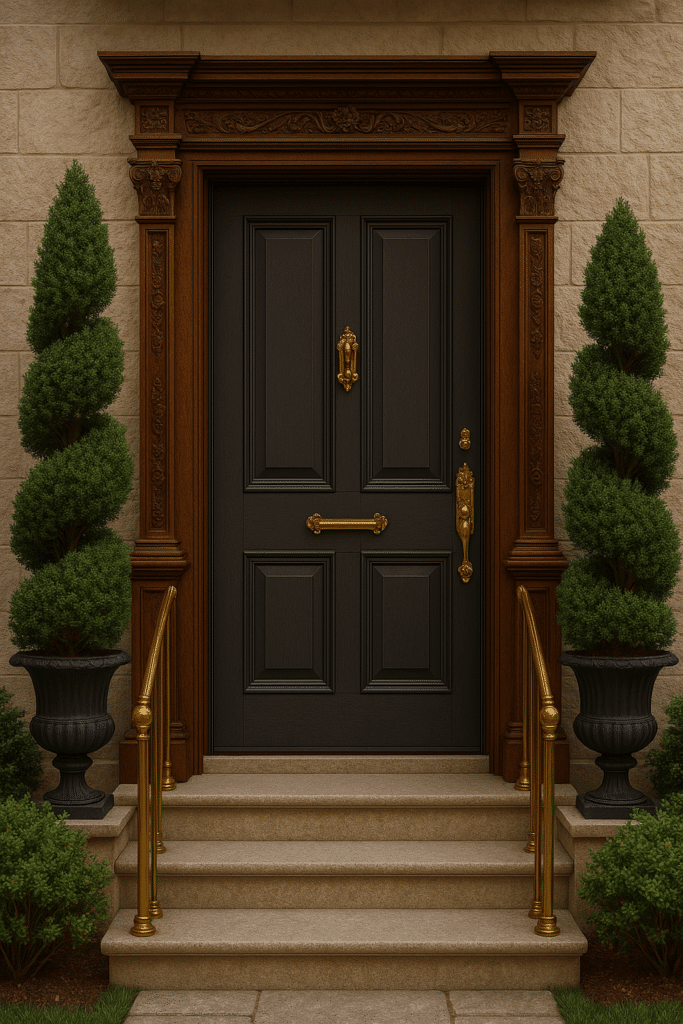
FAQs About Front Door Colors and Wood Doors
Q: Should I stain or paint my wood front door?
A: If you’ve got beautiful grain, stain it. If the door is beat up or you want a bold color, paint it.
Q: Can I use regular interior paint on my front door?
A: No. Use exterior-grade paint, or your hard work will peel, crack, and mock you within a year.
Q: How do I pick a color that won’t go out of style?
A: Stick with earth tones, natural stains, navy, black, or deep green. Trends come and go, but those stay sharp.
Q: Do I need to seal a painted wood door?
A: Yep. A good clear coat protects your color and the door itself from sun, rain, and wear.
Q: What’s the best finish for front doors—matte or gloss?
A: Satin or semi-gloss is the sweet spot. Matte shows grime, gloss looks cheap. Stick in the middle.
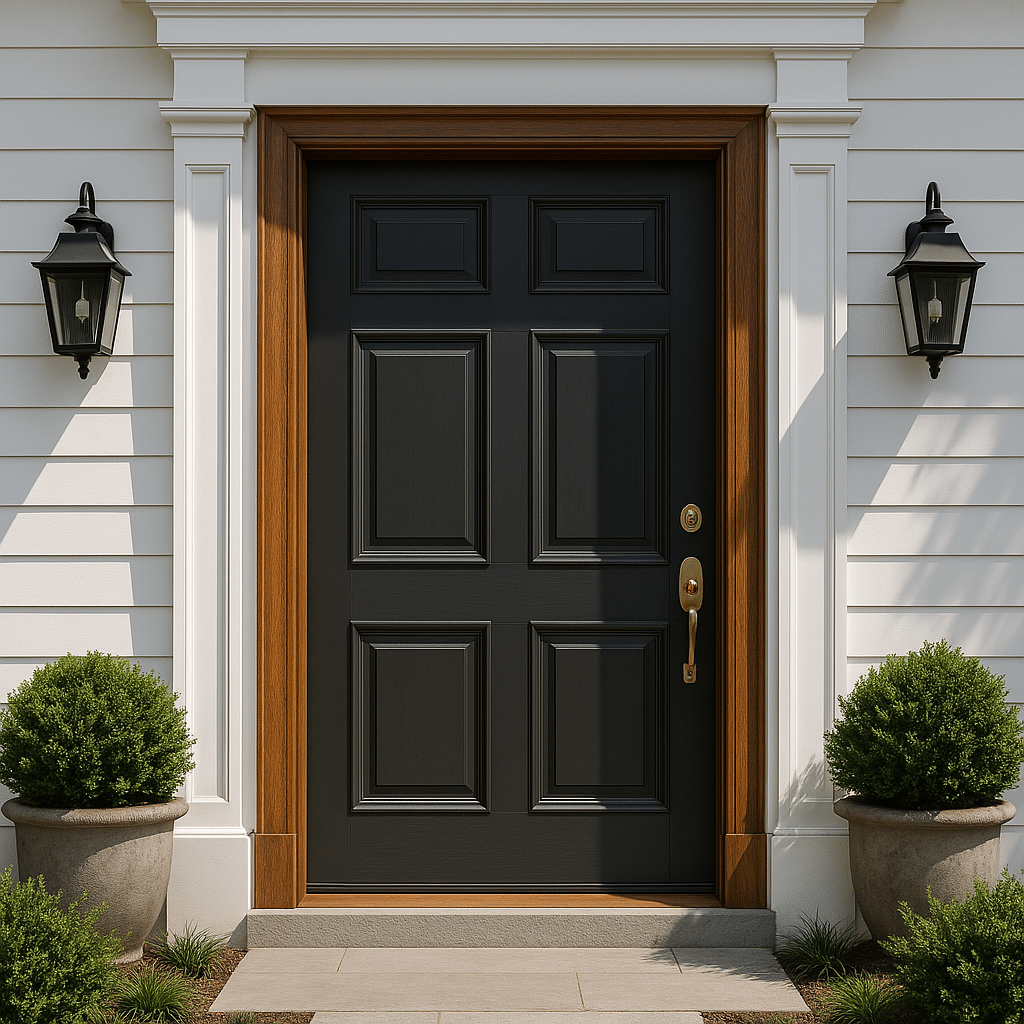
Front Door Colors: Here’s What It All Comes Down To
Front door colors matter. The right one makes your house feel expensive, inviting, and personal. If you’re lucky enough to have a wood front door, lean into it. Show off the grain. Or go bold with paint. Either way, your door sets the tone.
Whether you’re vibing with espresso-stained oak or a bold olive green, just make sure it reflects who you are—and holds up to sun, storms, and daily life. Because a great front door doesn’t just open to your house. It opens to the story you’re telling the world.
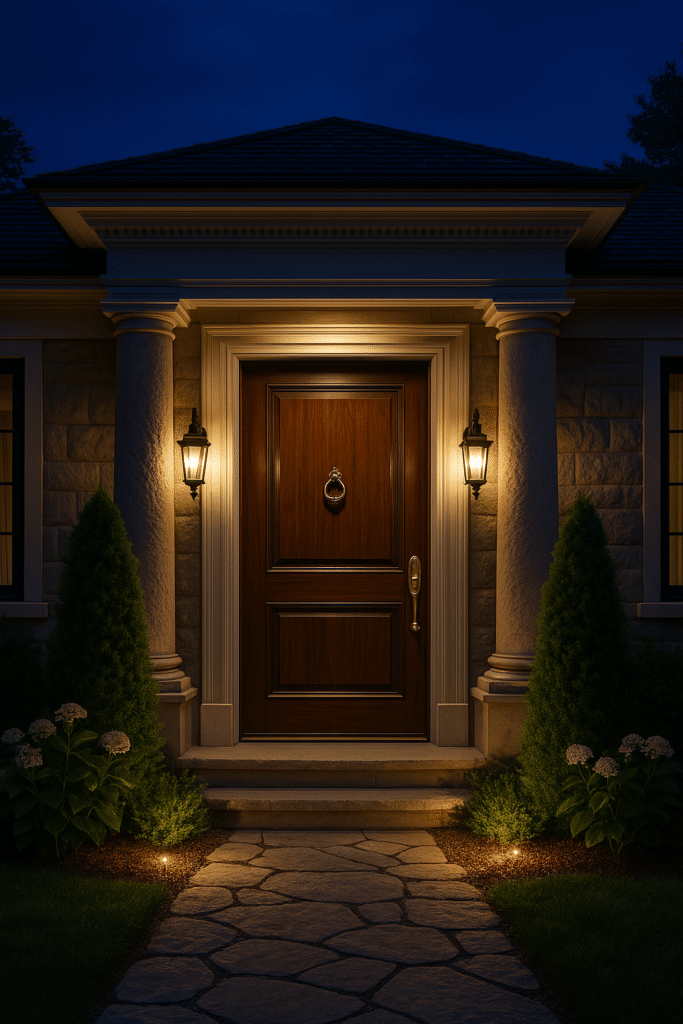
Let the grain shine or paint it with guts—but whatever you choose, make sure your front door color makes people say, “Damn, that looks good.”
Don’t treat your trim as an afterthought. The right combo with your front door color is like pairing the perfect belt with a custom suit—it ties the whole thing together.
